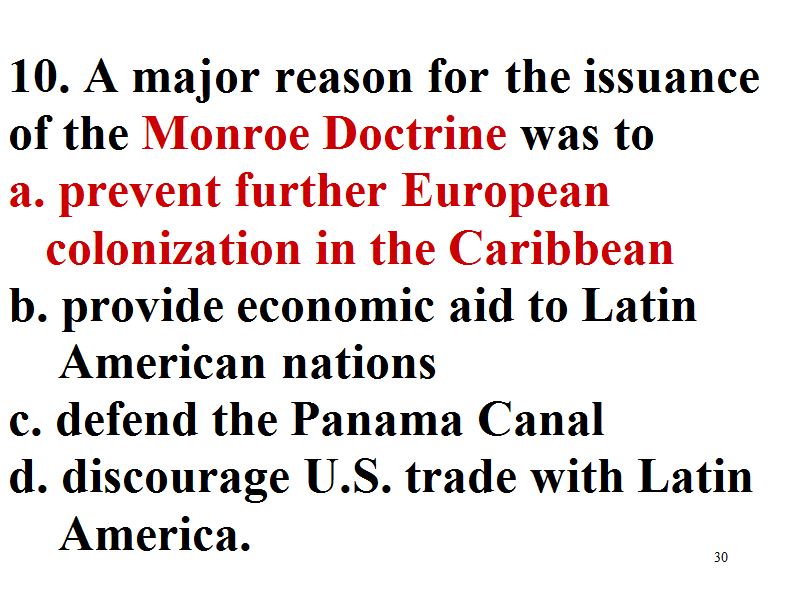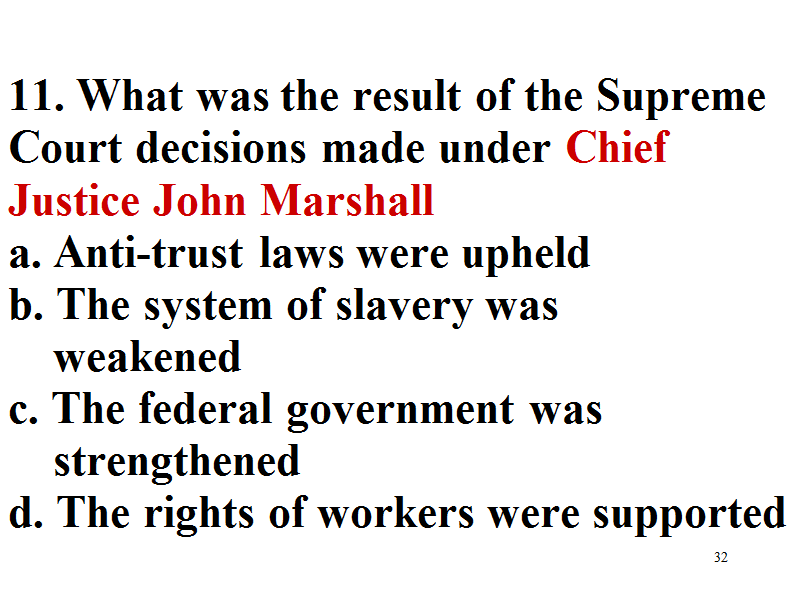| | - 1. Before the Civil War, the principle of popular sovereignty was proposed as a means of
- 1. Before the Civil War, the principle of popular sovereignty was proposed as a means of
- 1. Before the Civil War, the principle of popular sovereignty was proposed as a means of
- 2. The fourteenth amendment is important because, in addition to awarding citizenship to former slaves, it
- 2. The fourteenth amendment is important because, in addition to awarding citizenship to former slaves, it
- 2. The fourteenth amendment is important because, in addition to awarding citizenship to former slaves, it
- 3. The book A Century of Dishonor attempted to inform the public about the problems of
- 3. The book A Century of Dishonor attempted to inform the public about the problems of
- 3. The book A Century of Dishonor attempted to inform the public about the problems of
- 4. A major purpose of the Emancipation Proclamation was to
- 4. A major purpose of the Emancipation Proclamation was to
- 4. A major purpose of the Emancipation Proclamation was to
- 5. After the Civil War, serious differences between Congress and Andrew Johnson about how to handle Reconstruction led to the
- 5. After the Civil War, serious differences between Congress and Andrew Johnson about how to handle Reconstruction led to the
- 5. After the Civil War, serious differences between Congress and Andrew Johnson about how to handle Reconstruction led to the
- 6. As a strict constructionist, President Thomas Jefferson questioned the constitutional right to
- 6. As a strict constructionist, President Thomas Jefferson questioned the constitutional right to
- 6. As a strict constructionist, President Thomas Jefferson questioned the constitutional right to
- 7. Early in his Presidency, Abraham Lincoln declared his goal as President was to
- 7. Early in his Presidency, Abraham Lincoln declared his goal as President was to
- 7. Early in his Presidency, Abraham Lincoln declared his goal as President was to
- 8. Which newspaper headline best illustrates the principle of checks and balances?
- 8. Which newspaper headline best illustrates the principle of checks and balances?
- 8. Which newspaper headline best illustrates the principle of checks and balances?
- 9. What was the aim of the Dawes Act of 1887?
- 9. What was the aim of the Dawes Act of 1887?
- 9. What was the aim of the Dawes Act of 1887?
- 10. A major reason for the issuance of the Monroe Doctrine was to
- 10. A major reason for the issuance of the Monroe Doctrine was to
- 10. A major reason for the issuance of the Monroe Doctrine was to
- 11. What was the result of the Supreme Court decisions made under Chief Justice John Marshall
- 11. What was the result of the Supreme Court decisions made under Chief Justice John Marshall
- 11. What was the result of the Supreme Court decisions made under Chief Justice John Marshall
- 12. What effect did the Louisiana Purchase have on the U.S.?
- 12. What effect did the Louisiana Purchase have on the U.S.?
- 12. What effect did the Louisiana Purchase have on the U.S.?
- 13. The most long-lasting victory for civil rights achieved during Reconstruction was the
- 13. The most long-lasting victory for civil rights achieved during Reconstruction was the
- 13. The most long-lasting victory for civil rights achieved during Reconstruction was the
- 14. The major goal of the civil rights movement of the 1960’s was to
- 14. The major goal of the civil rights movement of the 1960’s was to
- 14. The major goal of the civil rights movement of the 1960’s was to
- 15. After the Civil War, the poll tax, literacy test, and grandfather clause were used to ensure that
- 15. After the Civil War, the poll tax, literacy test, and grandfather clause were used to ensure that
- 15. After the Civil War, the poll tax, literacy test, and grandfather clause were used to ensure that
- 16. Which historic period was marked by the military occupation of a portion of the U.S., attempts to remove the President from office, and major constitutional revisions?
- 16. Which historic period was marked by the military occupation of a portion of the U.S., attempts to remove the President from office, and major constitutional revisions?
- 16. Which historic period was marked by the military occupation of a portion of the U.S., attempts to remove the President from office, and major constitutional revisions?
- 17. Which term is most closely related to the U.S. concept of Manifest Destiny?
- 17. Which term is most closely related to the U.S. concept of Manifest Destiny?
- 17. Which term is most closely related to the U.S. concept of Manifest Destiny?
- 18. The passage of the Homestead Act and the completion of the transcontinental railroad helped to fulfill the U.S. commitment to
- 18. The passage of the Homestead Act and the completion of the transcontinental railroad helped to fulfill the U.S. commitment to
- 18. The passage of the Homestead Act and the completion of the transcontinental railroad helped to fulfill the U.S. commitment to
- 19. “Lincoln suspends Habeas Corpus”
- 19. “Lincoln suspends Habeas Corpus”
- 19. “Lincoln suspends Habeas Corpus”
- 20. Which Principle is illustrated by the passage of the Sedition Act of 1798, the suspension of habeas corpus in 1861, and the adoption of the Espionage Act in 1917?
- 20. Which Principle is illustrated by the passage of the Sedition Act of 1798, the suspension of habeas corpus in 1861, and the adoption of the Espionage Act in 1917?
- 20. Which Principle is illustrated by the passage of the Sedition Act of 1798, the suspension of habeas corpus in 1861, and the adoption of the Espionage Act in 1917?
- Slide 61
|




























































